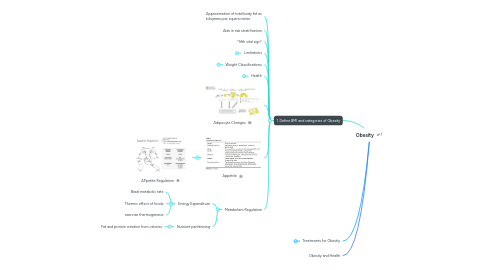
1. 1. Define BMI and categories of Obesity
1.1. Approximation of total body fat as kilograms per square meter
1.2. Aids in risk stratification
1.3. "fifth vital sign"
1.4. Limitations
1.4.1. Short stature
1.4.2. Large muscle mass
1.4.3. Edema
1.5. Weight Classifications
1.5.1. Underweight
1.5.1.1. < 18.5
1.5.2. Normal / Acceptable Weight
1.5.2.1. 18.5 - 24.9
1.5.3. Overweight
1.5.3.1. 25 - 29.9
1.5.4. Obese
1.5.4.1. Class I Obesity
1.5.4.1.1. 30 - 34.9
1.5.4.2. Class II Obesity
1.5.4.2.1. 35 - 39.9
1.5.4.3. Class III Obesity
1.5.4.3.1. ≥ 40
1.5.4.4. Class IV Obesity
1.5.4.4.1. ≥ 50
1.5.4.5. Class V Obesity
1.5.4.5.1. ≥ 60
1.5.5. Obesity Phenotypes
1.5.5.1. Normal Weight Obese
1.5.5.2. Metabolically Obese Normal Weight
1.5.5.3. Metabolically Healthy Obese
1.5.5.4. Metabolically Unhealthy Obese
1.6. Health
1.6.1. Metabolic and Physical Abnormalities
1.6.2. Mechanisms
1.6.3. Chronic Inflammation
1.7. Adipocyte Changes
1.8. Appetite
1.8.1. APpetite Regulation
1.9. Metabolism Regulation
1.9.1. Energy Expenditure
1.9.1.1. Basal metabolic rate
1.9.1.2. Thermic effect of foods
1.9.1.3. exercise thermogenesis
1.9.2. Nutrient partitioning
1.9.2.1. Fat and protein creation from calories
2. Treatments for Obestiy
2.1. Diets
2.1.1. High Fat vs High Protein
2.2. Bariatric Surgery
2.2.1. Restrictive procedures
2.2.1.1. Decrease food intake
2.2.1.2. Smaller portion size
2.2.1.3. Vertical Banded Gastroplasty
2.2.1.4. Adjustable Gastric Band
2.2.1.5. Gastric Sleeve
2.2.2. Malabsoprtive procedures
2.2.2.1. Decrease food absorption
2.2.2.2. Fewer calories "captured"
2.2.2.3. Duodenal Switch
2.2.3. Gastric Bypass
2.2.4. Complications
2.2.4.1. Procedure-Specific Complications
2.2.5. Outcomes
2.2.5.1. Men
2.2.5.2. Women
2.3. Pharmacotherapy
2.3.1. Pharmacotherapy
2.3.2. Pharmacotherapy
2.3.3. Weight Loss Results
